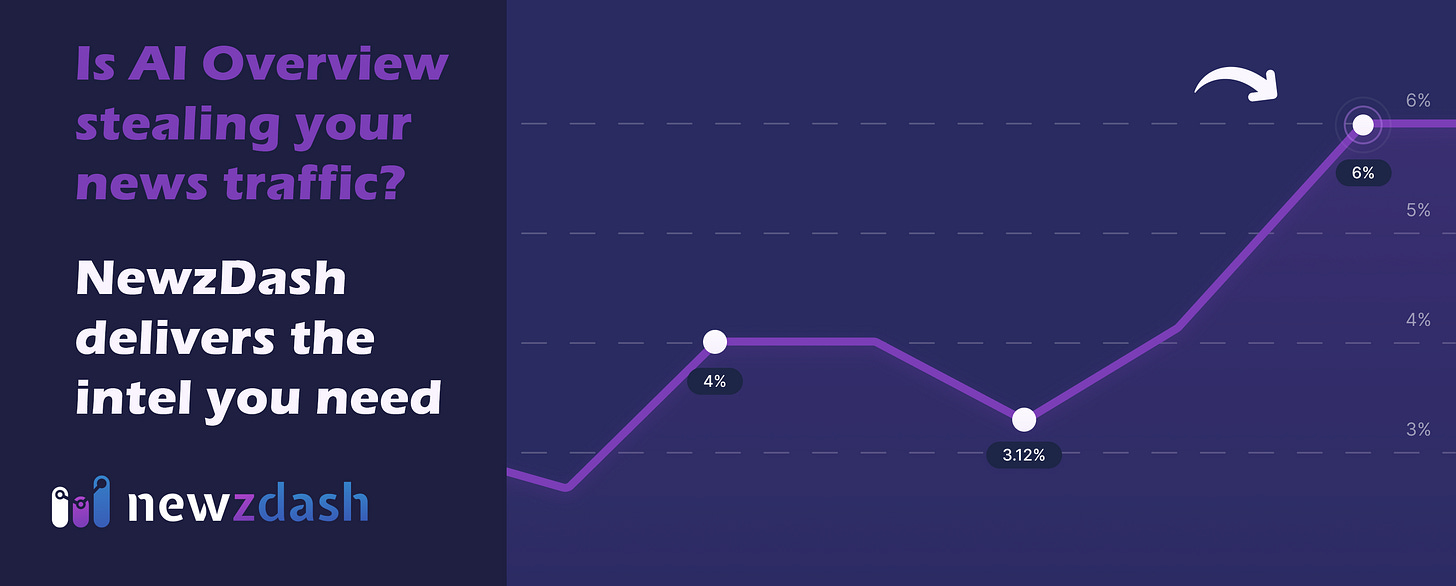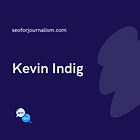Ask a News SEO: William Flannigan
William chats with us about SERP monitoring tactics and how that information can help predict where Google might be going next.
#SPONSORED
📉 Is Google's AI Overview stealing your news traffic?
NewzDash tracks AI Overviews for ALL trending news queries:
💡See which queries trigger AIOs
💡Track AIO presence in SERPs
💡Track your AIO rankings/mentions
💡Measure impact on News Visibility
💡Track time for AIOs to appear after events start
💡Understand AIO patterns (eg 6-9 hours post-event)
Hello, and welcome back. Jessie and Shelby here, back from another great summer weekend. Jessie spent an evening watching Aysanabee, Allison Russell and Canadian legends Blue Rodeo, and also crushed two softball games. Meanwhile, Shelby finally picked a college football team to cheer for (well, her team at The Athletic picked for her) — the Tennessee Volunteers. Stay tuned for more devastating intros about another football team that will break her heart.
This week: Ask a News SEO with William Flannigan! Will is an Senior SEO Editor for The Wall Street Journal and an avid Google watcher. He chats about SERP monitoring tactics, insights on where Google might be going next and advice for news SEOs working in a shifting search landscape
Join our community of news SEOs on Slack to chat any time.
Let’s get it.
WTF is SEO?: You monitor the SERPs more than most. What’s your approach, process and tools?
William Flannigan: I'm not doing anything wildly special. The Wall Street Journal uses several different tools to monitor our visibility and I always found that those tools are great for getting at historical data and measuring the horse race between publishers.
They’re useful, but I think they often have blind spots. They’re missing the whole picture.
In college, I had an English literature professor who said, "You're studying literature, so go where the books live — the library!" I’ve taken that approach with the SERPs (search engine results pages).
Things are just changing so quickly! To get a good sense of where you stand, you have to look at actual search results. Go incognito, go on mobile, go on desktop, sign up for Search Labs, create dummy Google accounts. Pretend to be a different kind of user, or somebody from a different part of the world to see how things are personalized.
I spend a lot of time updating, refreshing, trying different query combinations and going back and forth between mobile, desktop and just really paying attention to anything that seems new or out of place.
I look for the patterns to understand what Google's intent is. Once you do it long enough, you'll be able to predict what’s coming down the pike.
Tools offer a lot of scale, which is useful, but having that tactile SERP experience can provide so much more insight, in my opinion.
I, of course, follow folks like Barry Schwartz, Lily Ray, Glenn Gabe and Chris Long. Barry, in particular, is great at spotting and highlighting SERP changes.
Lastly, and this might sound creepy, but I spy on what people are looking at on their phones and what apps they use.
It is important to remember that Google is paying attention to that, too. Watching people’s phone habits can give you a lot of insight about what areas Google is thinking about pushing into.
WTF is SEO?: Having done this for a couple years, how have things changed?
William Flannigan: We have to remember that Google, like any company, responds to user behaviour, feedback and the market.
The rise of ChatGPT, and other Gen AI tools, caught Google's attention. So they’re going to respond.
I’m old enough to remember a time when Google was only 10 blue links. Today, we see a lot more volatility and a lot more dynamism in the SERPs now.
Google is offering more ways to experience search results now than they ever have. It’s a choose-your-own-adventure SERP.
That's to Google's benefit because it's giving them feedback anytime somebody clicks on a short video filter, for example, or the News tab or the web view.
Google takes all this, ingests it and responds to those user behaviours as quickly as they can.
I’ve noticed that I’m seeing a lot more influencers, creators and small publishers popping up in SERPs recently, which is definitely something to pay attention to.
WTF is SEO?: What do you think about personalization and multimodal search?
William Flannigan: Google has had a personalized search experience for a while in that it takes into account your geography.
But, take a step back and look at what Google and these AI companies are doing. They’re buying up and building a bunch of data centres — that’s computing power being put towards something. I imagine that personalization is going to be a big part of that. The reason why we haven't had highly personalized SERPs yet is, I think, just the lack of computing power.
At Google IO this year, they talked quite a bit about this idea of “Personal Context” in search. Essentially, Google says it will take a holistic view of a user and give them a unique SERP experience.
What does that mean for news publishers? We don’t know yet, but it seems to me like SEO will be more than just optimizing headlines in the future.
A couple of weeks ago, Google rolled out “Preferred Sources” across the U.S. and India. This is just a prologue to something bigger.
We don't know every way Google will use that user feedback, and the other places preferred sources will show up — it might be AI Mode.
All of these developments are baby steps to something larger: In the future, my search experience will likely be very different from your search experience. Google is taking all the lessons it’s learned from Discover, AIOs and AI Mode and bringing those into one experience to rule them all.
WTF is SEO: How do publishers react and respond to volatility?
William Flannigan: The best thing to do right now is accept that we are no longer in a mass media monoculture. The first thing I would do is SEO Everything Everywhere All At Once.
First, make sure you are doing the SEO fundamentals well.
Then put your social, SEO and video teams in the same room.
Social media is the primary information source for many people and video is their preferred mode, especially if you're under a certain age. It stands to reason that there's a lot of potential growth for SEOs in those areas. SEOs can help optimize social headlines and video ideas. Take all the lessons in SEO you’ve learned over time and translate that to video and audio.
Next, treat your newsroom like a client and your team like an agency.
Trust in people is higher than trust in brands — and the news influencer economy is taking off.
The sooner your SEO and social teams work as an agency to support your reporters and editors, the better.
Socially savvy reporters will expand and extend the reach of your brand further than an ad buy or marketing plan. So help them do it.
And guess what AI can't make right now? Personality-driven short form video on location.
All of this leads to more discoverability, reach and brand recognition which will boost your SEO in the long run.
WTF is SEO?: What is one thing you wish you knew earlier in your news SEO career?
William Flannigan: I’ve had the opportunity to do a lot of different things in newsrooms.
SEO was not my first love. I fell into it. And I came into it at an interesting time.
If I could give advice to my younger self, it would be to chase the fun and be loud about it.
I would say recognize that boredom is your motivation killer. I need to be constantly moving, iterating and trying new things — that’s what gives me energy. That’s what drives me. That’s what I’m passionate about: looking over the next hill.
And I’ve found that if I'm legitimately passionate about something, it's easier for me to rally people to my cause, which is a big thing in SEO.
I watched an interview with Conan O’Brien recently. He was asked what made him so successful, and his answer was (I’m paraphrasing) that he leapt into things before he could talk himself out of it.
So If I were to give advice to someone else, I’d say: Even if you can't think of a way that SEO is necessarily directly involved with something going on in your newsroom, try to nudge your way in and be willing to use those fundamental SEO skills in new ways. Those skills translate. Data analysis, audience analysis, keyword or topic plans — these skills translate across the newsroom. Don't be afraid to put those skills to use in new ways.
Lastly, surround yourself with people who want to have fun, because it’s contagious. And so is doomerism — be fearful of the doomers!
#SPONSORED - The Classifieds
Get your company in front of more than 13,000 writers, editors and digital marketers working in news and publishing. Sponsor the WTF is SEO? newsletter!
RECOMMENDED READING
Google news and updates
🤖 Google: Preferred Sources launches in the U.S. and India
🤖 Barry Schwartz: AI Mode expands to 180 countries.
🤖 Google: Launching Flight Deals, an AI-powered tool.
Even more recommended reading
🛍️ Glenn Gabe: Wirecutter has dropped heavily in search visibility over the past four months.
🔽 Press Gazette: All but four of the 50 biggest English-language news sites in the world saw traffic decline in July.
⌨️ Dan Petrovic: OpenAI’s latest model, GPT-5, has made SEO irreplaceable.
🔍 Barry Schwartz: Is Google using a generic and undocumented crawler?
🧑💻 Roger Montti: Content generated by AI should always be reviewed by a human, says Gary Illyes.
💬 Helen Pollitt: Here’s how to speak the language of your key SEO stakeholders.
What did you think of this week's newsletter?
(Click to leave feedback.)
Catch up: Last week’s newsletter
Have something you’d like us to discuss? Send us a note on Twitter (Jessie or Shelby) or to our email: seoforjournalism@gmail.com.
Written by Jessie Willms and Shelby Blackley









